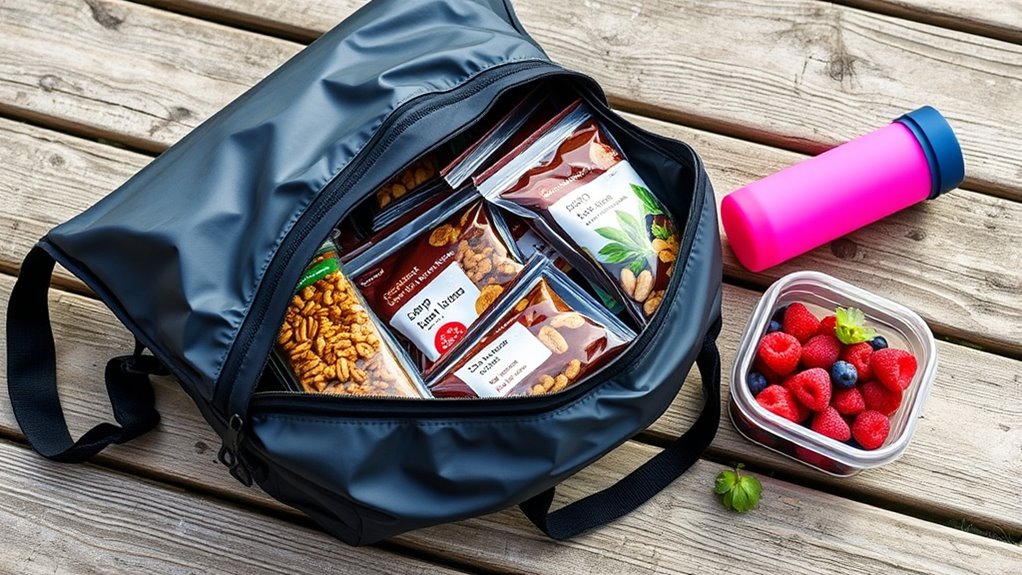To pack water-resistant snacks for floating days, select waterproof containers made from durable plastic or silicone to keep items dry and secure. Use resealable, airtight bags for smaller snacks like chips or fruit, squeezing out excess air for extra freshness. Consider waterproof gear or lining backpacks with waterproof bags for added protection, especially if water contact is likely. Organize your snacks in layers and check seals regularly to prevent leaks — more tips ahead can help you stay thoroughly prepared.
Key Takeaways
- Use waterproof containers made from durable, airtight materials to keep snacks dry during water-based activities.
- Pack snacks in resealable bags, squeezing out excess air and double-bagging for added moisture protection.
- Line backpacks or coolers with waterproof bags or covers to prevent water ingress and protect snack storage.
- Opt for individual snack portions in small containers to reduce risk of leaks and make access easier.
- Regularly inspect and ensure all packaging is properly sealed to maintain freshness and prevent water damage.

When you’re packing snacks for outdoor adventures or rainy days, protecting them from water is essential. Whether you’re heading out for a hike, a boat trip, or just expecting unpredictable weather, moisture can quickly ruin your snacks and waste your efforts. To keep your treats fresh and dry, start with the right containers. Waterproof containers are your best bet—they’re sturdy, airtight, and designed to prevent water from seeping in. Look for those made from durable plastics or silicone, which can withstand rough handling and keep moisture out. These containers are especially useful for items like granola bars, nuts, or fruit that you want to keep dry and intact.
Use waterproof, airtight containers made from durable plastics or silicone to keep snacks dry during outdoor adventures.
Resealable bags are another versatile option. They’re lightweight, easy to pack, and can be sealed tightly to prevent water from getting inside. Use high-quality resealable bags for snacks like chips, dried fruit, or small cookies. Before sealing, squeeze out as much air as possible to minimize the risk of moisture exposure and to help keep the snacks fresh longer. For added protection, double-bag items or place the resealable bags inside waterproof containers. This layered approach creates multiple barriers against water and ensures your snacks stay dry even if your pack gets splashed or if it rains unexpectedly.
When packing for floating days or activities where water contact is likely, consider waterproof bags designed specifically for outdoor gear. These bags are often made from waterproof fabrics with sealed seams and roll-top closures that create a watertight seal. Using these for your snack storage adds extra security, especially if you’re worried about water spills or accidental submersion. You can also line your backpack or cooler with a waterproof bag for added protection, giving you peace of mind that your snacks won’t get soggy or ruined. Incorporating waterproof gear can significantly enhance your moisture protection strategy and help preserve your snacks more effectively.
Another tip is to organize your snacks in smaller, individual portions. This way, if a bag or container does get compromised, only a small amount of your snacks is affected. Plus, it makes it easier to grab just what you need without exposing other snacks to potential moisture. Always check your containers and resealable bags before heading out to ensure they’re properly sealed and in good condition. Properly packing your snacks using waterproof containers and resealable bags not only preserves their quality but also makes your outdoor experience more enjoyable. No matter the weather or activity, these simple steps help keep your snacks dry, fresh, and ready to enjoy.
Frequently Asked Questions
What Types of Snacks Are Best for Water Resistance?
You should choose snacks with high durability testing and strong packaging materials for water resistance. Opt for sealed, waterproof containers or vacuum-sealed packages that prevent water ingress. Dried fruits, nuts, granola bars, and jerky are excellent because they’re naturally moisture-resistant. Avoid snacks that are prone to sogginess or require refrigeration. Using sturdy packaging materials guarantees your snacks stay dry and fresh during floating days.
How Do I Prevent Snacks From Getting Crushed?
Imagine your trail mix gets crushed during a floating adventure. To prevent this, use snack cushioning like bubble wrap or crumpled paper inside your packaging. Opt for sturdy, airtight containers and layered packaging techniques to absorb shocks and keep snacks intact. You might also consider vacuum-sealing delicate items. These steps will safeguard your treats from getting crushed, ensuring they arrive fresh and undamaged, ready to enjoy anytime.
Can I Use Reusable Containers for Water-Resistant Packing?
Yes, you can use reusable containers for water-resistant packing. Opt for containers made from durable, waterproof materials like silicone or high-quality plastic to keep your snacks dry. Make sure they have tight-fitting lids to prevent leaks and provide an extra layer of protection. Reusable containers are eco-friendly and convenient, ensuring your snacks stay safe from water exposure during floating days, and they’re easy to clean for repeated use.
What Are the Signs of Water Damage in Snacks?
Signs of water damage in snacks include soggy, swollen, or slimy snack packaging. You might notice moisture indicators on the packaging turning a different color, signaling dampness inside. If your snacks feel damp or look distorted, it’s a clear sign of water infiltration. Stay alert for unusual textures or odors, as these often indicate moisture intrusion. Proper packaging prevents this and keeps your snacks fresh and safe for floating days.
How Long Can Water-Resistant Snacks Stay Fresh?
Water-resistant snacks can stay fresh for several days, depending on packaging durability and snack type. Properly sealed, they preserve snack flavor and prevent moisture from seeping in, maintaining taste and texture. If your packaging remains intact, expect freshness to last up to a week. Keep an eye on any signs of damage, as compromised packaging can shorten shelf life and affect snack flavor preservation.
Conclusion
Now that you know how to pack water-resistant snacks, you’ll stay fueled during your floating days without worry. Did you know that over 70% of outdoor enthusiasts face snack spoilage due to moisture? By using these simple tips, you can keep your snacks dry and fresh, ensuring your adventure goes smoothly. So, pack smart, stay prepared, and enjoy every moment on the water — your taste buds (and your trip) will thank you!










